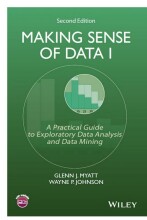Summary: Making Sense Of Data I A Practical Guide To Exploratory Data Analysis And Data Mining | 9781118422106 | Glenn J Myatt, et al
- This + 400k other summaries
- A unique study and practice tool
- Never study anything twice again
- Get the grades you hope for
- 100% sure, 100% understanding
Read the summary and the most important questions on Making Sense of Data I A Practical Guide to Exploratory Data Analysis and Data Mining | 9781118422106 | Glenn J. Myatt; Wayne P. Johnson
-
2 Describing Data
-
2.1 Overview
This is a preview. There are 5 more flashcards available for chapter 2.1
Show more cards here -
A data table contains what, represented as
The measured or collected data values, represented as numbers or text -
What information is shown in the rows of data tables?
Individual items -
2.2 Observations and Variables
This is a preview. There are 4 more flashcards available for chapter 2.2
Show more cards here -
What contains information about a specific item they represent, and what are they referred to?
Rows, referred to as observations -
What is a set of values, what does it describe, and where is it described?
A variable, describing some aspect across all observations, described in the columns -
In a spreadsheet, what is described in the rows and columns?
Raw Data -
What is essential to know before data analysis or data mining and what is the first step to understanding?
The data table
The first step is to understand the individual variables -
2.3 Types of Variables
This is a preview. There are 12 more flashcards available for chapter 2.3
Show more cards here -
What helps us understand the precision of an individual variable?
Scales -
What are 4 types of scales that help make choices about data visualization as well as methods of analysis?
Nominal scale
Ordinal scale
Interval scale
Ratio scale -
What scale describes variables where both intervals between values and ratios of values can be compared?
Ratio scale -
What variable contains two values, 0 and 1, and provides a convenient numeric representation for many different types of dissect data?
Binary variable
- Higher grades + faster learning
- Never study anything twice
- 100% sure, 100% understanding
































